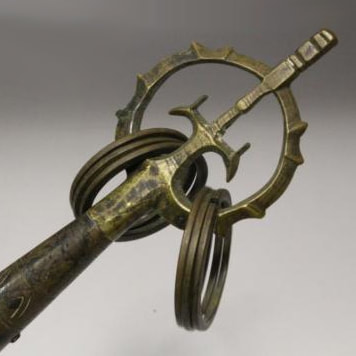Case 31: Magu Circles the Chan Seat
Magu went to Changqing* and, holding his staff, walked around his Chan seat three times. He brought his staff firmly to the floor, shaking the bells, and stood straight.
Changqing said, “Right, right!” (Xuedou: A mistake!)
Magu then went to Nanquan and walked around his Chan seat three times. He brought his staff firmly to the floor, shaking the bells, and stood straight.
Nanquan said, “Not right, not right!” (Xuedou: A mistake!)
Magu said, “Changqing said ‘Right, right!’ and you said, ‘Not right, not right!’ Why is that?”
Nanquan said, “Changqing is right, but you are not right. Your action is the movement of the wind. In the end it will perish.”
*Chenzhou is the name of a place.
Philip asks me to find him a shakujō!
This is a real story, not a made up story that sings its own song into the wind.
In preparation for his Mountain Seat, Philip called me to his room and pointed me to the third drawer down in a small Japanese cabinet.
He asked, “See that funny thing with all rings? It’s meant to sit on the top of a pole. Find me a pole. It has to fit on tight so that it won’t fall off.”
I picked up an odd looking thing, wondering what it was actually. About six rings held together by another brass ring right at the bottom of which was a kind of oversized thimble shape. It seemed to be about 2 inches in diameter but it was obviously Japanese and so it would be an odd metric size.
Off I went around the corner to Cliffs Hardware with the funny brass thimble thing in my pocket to examine what poles they had in stock. I tried them all, and finally found a broom with a handle probably 56 inches long, but the top had been carefully rounded off so that hard edges didn’t cut the hard working hands of an overburdened housewife. It actually accepted the convex female shape of the jingle jangle thing perfectly. The broom part was detachable. It screwed otf.
I paid 15 dollars and ran back to Hartford Street. I showed Phil, actually I handed it to him so that he could examine it with his fingers, blind as a bat. He liked the way the pole met the ring that corralled the rest of the rings. Then I unscrewed the brush and handed him the pole as he stood up. He bashed it to the floor and shouted “Too short. Taller, kid, taller. I need to hold it about here and walk in a measured pace.” He put out his arm and I could see that the top of the pole was below his shoulder. It needed another foot.
I had kept the sales slip so I screwed the broom back on the handle and rushed back to Cliffs. But I couldn’t find another broom with a tapered stick that was long enough. So I looked at the long poles. I would have to take a chance and have one cut. The problem was that they were either way too thick and would never accept the jingle jangle thimble or way too thin and just didn’t have the substantial feel of a walking stick. There was a deadline. I had to choose and put my money down. Cut it to 72 inches at 3 bucks a foot. I took a chance. It offended my aesthetic sense though. A straight cut at the top of the thin pole set the jingle jangle thimble askew, but I could get some thin nails long enough to keep it from popping off.
Phil grabbed the stick and hit the ground. The rings were near enough to his ear to make the proper sound and he smiled. He draped some ribbons through the rings, and banged what was now his shakujō on each step as he descended the stairs into the zendo where inherited the Mountain Seat from Steve.
Later though the stick did not support when it would all end. Blind as a bat he reached back for the chair that wasn’t there and fell, breaking his assbone, never to take a seat ever again.
That is also true. The whole thing is True oh so true right to the metric size of the Jingle Jangle Rings and the Fall ass backwards which turned out Wrong oh so wrong. Right right.
The Verse
For each of us there is a place
Wherein we will tolerate no disorder.
We habitually clean and reorder it,
But we allow many other surfaces and regions
To grow dusty, rank and wild.
So I walk as far as a clump of bay trees
Beside the creek’s milky sunshine
To hunt for words under the stones
Blessing the demons also that they may be freed
From Hell and demonic being
As I might be a cop, “Awright, move it along, folks,
It’s all over, now, nothing more to see, just keep
Moving right along”
I can move along also
“Bring your little self and come on”
What I wanted to see was a section of creek
Where the west bank is a smooth basalt cliff
Huge tilted slab sticking out of the mountain
Rocks on the opposite side channel all the water
Which moves fast, not more than a foot deep,
Without sloshing or foaming.
“The Bay Trees Were About to Bloom"
Tassajara, 11:II:79
Philip Whalen
A Song for the Wind
Jingle Jangle
Bingle Bangle
Bingo Bango
Trimble Tangle
Tinkle Tango
Oh oh oh
No no no
Too short, too tall
Too thick, too thin
Too heavy, just right
Curmudgeon,
Superlative Mudgeon
Ah
Fly away
Spingle Spangle
Humpty Dumpty
Crummy Bunny
Tangle untangle
Bing Bang
Walla walla
Bang bang
Thump thud
The end
Good bye dear Phillip.
I am in tears.
